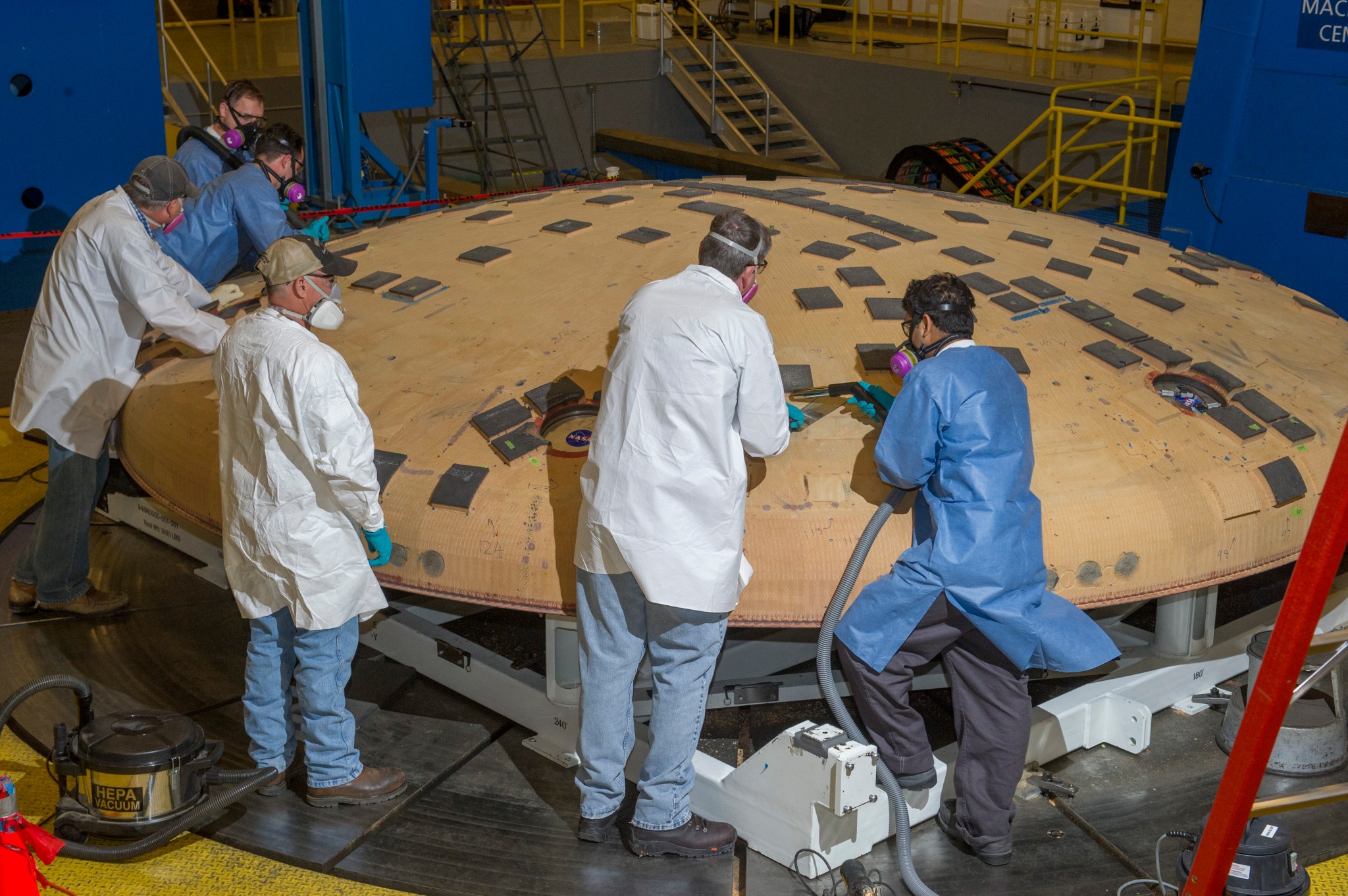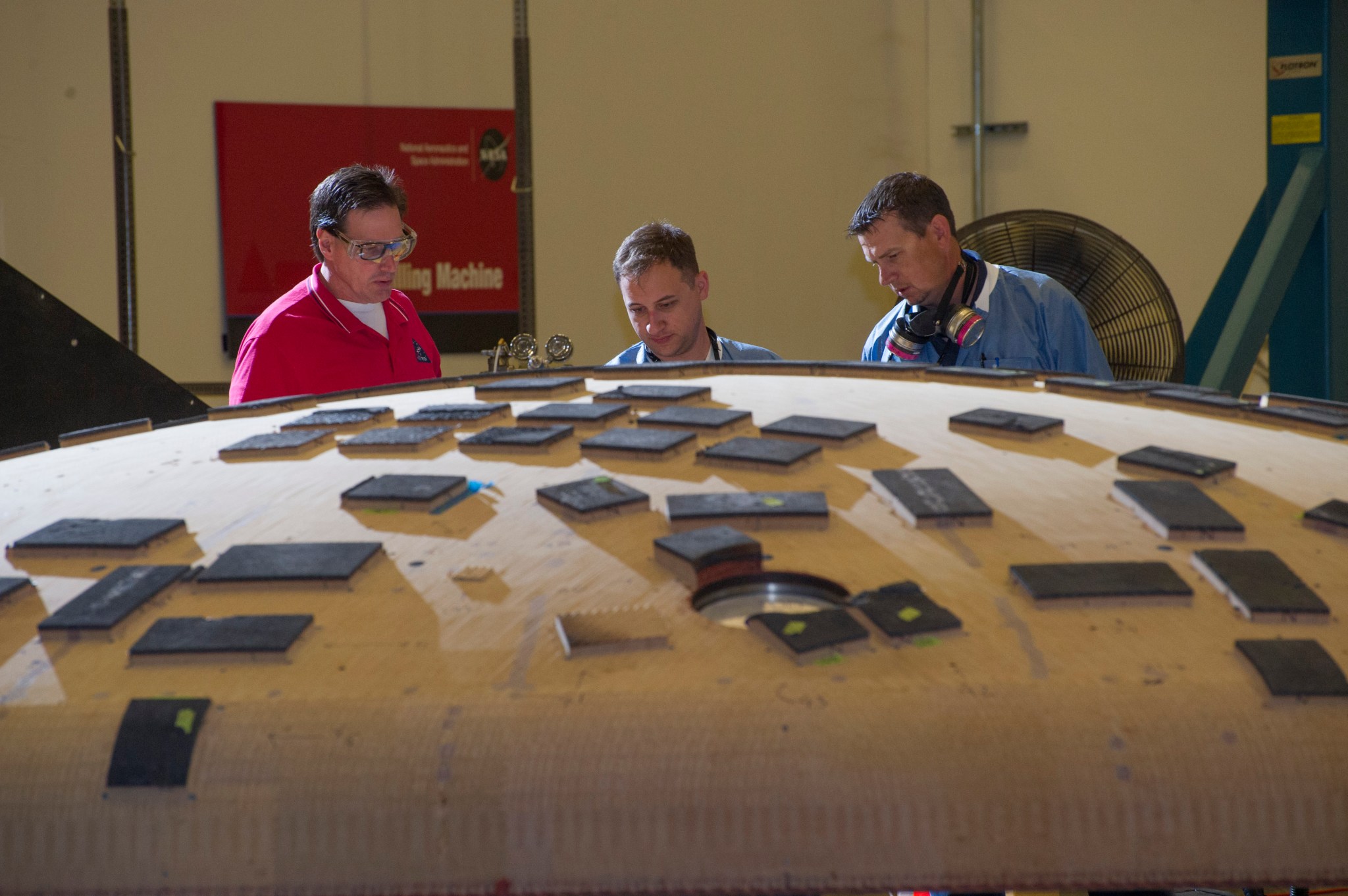
The harsh buzz of powered cutting tools reverberates in the close air of Building 4705 at NASA’s Marshall Space Flight Center in Huntsville, Alabama, as a dozen or so technicians and engineers work to remove burnt ablative material — the incinerated outer layer of a spacecraft’s heat shield — from the massive, dish-shaped structure at the center of the facility.
The team includes researchers from three NASA field centers, each supporting development of the Orion crew module, the exploration spacecraft set to carry future astronauts on missions of discovery to an asteroid and on toward Mars. Clustered around the heat shield are thermal protection engineers from NASA’s Ames Research Center in Moffett Field, California; milling and machining engineers from Marshall; and thermal protection subsystem managers from NASA’s Johnson Space Center in Houston, which manages the Orion program for the agency. Also on hand are representatives from Lockheed Martin of Huntsville, the NASA prime contractor which built Orion and its heat shield for the agency.
Since May 4, the workers have gathered in this expansive, storied Marshall building — where NASA teams fabricated elements of the Apollo-era Saturn rockets — to remove for analysis the last 180 or so small squares of an ablative material called Avcoat, the outer coating of Orion’s 16.5-foot-diameter heat shield.
Many of the squares, charred during the successful Exploration Flight Test-1 in 2014, contain sophisticated data-gathering sensors, designed and fabricated at Ames and used to collect critical entry environment and thermal protection performance data as Orion made its fiery reentry and splashed into the Pacific Ocean.
The delicate nature of those sensors is a key reason the facility was tapped to conduct the Avcoat removal work, said Matthew Pruitt, the Marshall engineer who leads the milling effort.
State-of-the-art capabilities
Upon its arrival at Marshall March 9, the heat shield was delivered to Building 4705, which houses NASA’s state-of-the-art, seven-axis milling and machining facility. The seven-axis machine uses precision, computer-aided tools able to fluidly maneuver in a variety of ways to manufacture parts and cut large metal or composite materials or structures.
It is the largest such machine in the world — other than its twin, which currently supports next-generation aerospace work at NASA’s Michoud Assembly Facility in New Orleans. Both were built for NASA by Ingersoll Machine Tools of Rockford, Illinois, which also supports Orion fabrication — as a subcontractor to Lockheed Martin — for the Exploration Mission-1 test flight. During that mission, an uncrewed Orion will conduct a wide circle around the moon before returning to Earth to safely splash down in the Pacific.
The seven-axis machine boasts a fixed, rotating “table,” Pruitt said, which enables researchers to easily inspect and conduct work on large-scale structures such as the 5,000-pound heat shield. Also in use is a heavy piece of Lockheed Martin Ground Support Equipment, which enables the heat shield to be suspended from any angle for ease of access — and helps minimize impacts to the vehicle that might have been caused in the past by large-scale loaders or lifting clamps.
Improved handling techniques help minimize the analysts’ need to separate actual material ablation and other effects of atmospheric entry and descent from damage caused after its return to Earth. “That’s essential for this kind of work, where the physical condition of the heat shield is crucial to understanding the impact of reentry on the material,” Pruitt said.

A planned partnership
Leveraging a NASA Space Act Agreement partnership with Marshall, Lockheed Martin helped orchestrate the material-removal operation, obtaining additional support services and fulfilling other requirements to expedite critical post-flight processing.
“What began as a basic plan to remove the Avcoat became a successful team effort to extract critical data and prepare the heat shield for its next planned use,” said Terry Abel, Lockheed Martin’s technical liaison to Marshall.
The integrity of that data is vital to researchers studying high-speed flow and burn characteristics, said Dr. Deepak Bose, senior scientist in Ames’ Space Technology Division. His team, which leads the heat shield analysis effort for NASA, must be able to trust and properly interpret the empirical data provided by the heat shield to accurately compare those findings to NASA’s ablation models, validating or refining them for future planetary-entry/reentry decision-making.
How much of the ablative material burned off? Where? Why? These are questions Bose and his team ask during analysis, he said, “to refine our ability to deliver state-of-the-art thermal protection systems that will keep our astronauts and spacecraft safe in their journeys.”
He indicates one of the charred Avcoat squares being cut free and lifted away from the heat shield by workers in protective white suits.
“The answers start there,” he said.
Once the Orion team removes the final pieces by hand, all those sensors and chunks of ablated material will be secured for shipping to Ames and other NASA facilities for further study. Ames teams that tested and qualified the materials prior to flight, using the nation’s premiere arc jet facilities, will analyze the thermal performance of the material.
Data gleaned from the samples, and from the heat shield’s behavior during reentry, will help researchers refine predictive computer models and assist technologists in developing safer, more cost-effective ways to design and build these critical protection systems.
Finishing touches
To wrap up the heat shield milling process, the seven-axis milling machine will be used to make a final pass, its cutting tool spinning at 7,000 rpm to cull material at a top rate exceeding 180 inches per minute. The innovative, built-in vacuum system sucks up the dust from the excised Avcoat material.
The stripped Avcoat covering will be smoothed to a uniform layer approximately one-tenth-of-1-inch thick above the shield’s composite inner surface. In early June, it will be readied for transfer to NASA’s Langley Research Center in Hampton, Virginia, for water-impact testing.
Analysis of the heat shield materials and sensor data will continue for the next six months or so, Bose said. Then the findings will be presented to the wider Orion program team, and will impact development of the next flight test vehicle.
Pruitt is proud of the team, as it carries on developing Orion for human explorers. “This has been an example of world-class machining work by an expert team,” he said.
The Orion spacecraft will launch atop the Space Launch System, the nation’s heavy-lift rocket currently in development. Visit NASA on the Web for more information about Orion, its flight test and NASA’s journey to Mars.

























